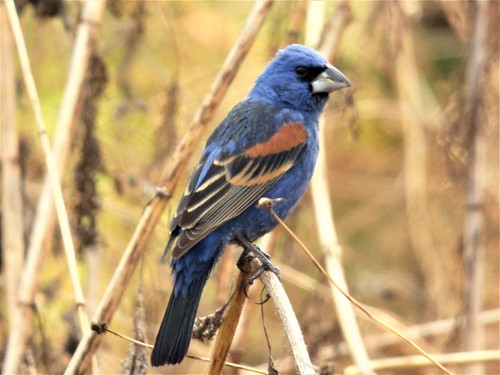
Blue Grosbeak
The Blue Grosbeak (Passerina caerulea) is a striking songbird known for its vibrant blue plumage in males and its robust, seed-cracking bill. This species plays an important ecological role as a seed disperser and insect consumer. It is found across a wide range of habitats in North and Central America. While not currently considered globally threatened, some populations face localized pressures. It holds a place in some cultures as a symbol of change and transition due to its migratory habits.
15-19 cm
Length
26-29 cm
Wingspan
Least Concern
Conservation Status
Distribution
Breeds across the southern United States, from California to New Jersey, and south into Mexico and Central America. Winters in Central America and the Caribbean. Migratory routes vary, with some populations undertaking long trans-Gulf flights.
Lifespan
Average lifespan in the wild is unknown, but likely around 2-5 years. Maximum recorded lifespan in captivity is over 7 years.
Blue Grosbeak's Habitat
Habitat Types
Shrublands, Open woodlands, Agricultural fields, Roadsides, Forest edges
Climate Zones
Temperate, Subtropical, Tropical
Adaptations
Their strong, conical bills are adapted for cracking seeds, a primary food source. They are also adaptable to a variety of open and semi-open habitats, allowing them to thrive in human-altered landscapes.
Variations
Several subspecies are recognized, differing slightly in size and plumage coloration. For example, western populations tend to be slightly paler than eastern ones.
Appearance
Breeding Plumage
Adult males in breeding plumage are a deep, rich blue with black wings and two prominent rusty or chestnut wingbars. Non-breeding males are duller, with more brown mottling. Females are mostly brown with buffy wingbars.
Seasonal Feather Changes
Males molt into their brighter breeding plumage in late winter or early spring. After breeding, they molt into a duller, non-breeding plumage.
Sex Based Plumage Differences
Strong sexual dimorphism in plumage. Males are brightly colored, while females are much more cryptic.
Notable Features
Large, conical bill, Two prominent wingbars, Long, slightly notched tail
Diet and Feeding
Primary Foods
Seeds, Insects, Grains, Fruits (occasionally)
Foraging Behavior
Forages on the ground and in low vegetation. Often hops or runs while searching for food. Will glean insects from leaves and twigs. May visit bird feeders, especially for sunflower seeds.
Specializations
The large, powerful bill is specialized for cracking open hard seeds.
Seasonal Diet Variations
Diet shifts seasonally. During the breeding season, insects make up a larger proportion of the diet, providing protein for growing chicks. In winter, seeds and grains are the primary food sources.
Behavior
Social Structure
Generally solitary or found in pairs during the breeding season. May form small flocks during migration and in winter.
Communication
Song is a rich, warbling series of notes., Call notes include a sharp 'chink' sound., Males sing to defend territory and attract mates.
Migration
Migratory, with most populations moving south for the winter. Some populations in the extreme southern US and Mexico may be resident year-round. Migration is often nocturnal.
Territorial or Group Behaviors
Males are territorial during the breeding season, defending their nesting area from other males. Outside of the breeding season, they are less territorial.
Conservation
Threats
Habitat loss (due to agriculture and urbanization), Pesticide use (reducing insect prey), Collisions with buildings and vehicles
Protection Programs
Conservation of shrubland and grassland habitats, Efforts to reduce pesticide use, Monitoring programs (e.g., Breeding Bird Survey)
Local National Laws
Protected under the Migratory Bird Treaty Act in the United States.
Population Trend
Generally stable, but some regional declines have been noted.
Population Estimates
Global population estimated at around 14 million individuals.
Interesting Facts
Blue Grosbeaks sometimes incorporate unusual materials into their nests.
This includes snakeskin, onion skin, and even pieces of paper or plastic.
They are known to hybridize with Lazuli Buntings.
Where their ranges overlap in the western United States, occasional interbreeding occurs.
Young males often learn their songs from neighboring males.
Rather than solely from their fathers, contributing to regional song dialects.
Faqs about Blue Grosbeak
What is the difference between a male Blue Grosbeak and a male Indigo Bunting?
Blue Grosbeaks are larger, have a much larger bill, and have prominent wingbars, which Indigo Buntings lack.
Do Blue Grosbeaks visit bird feeders?
Yes, they may visit feeders, especially those offering sunflower seeds or millet.
Where can I see a Blue Grosbeak?
Look for them in open, shrubby habitats, roadsides, and forest edges during the breeding season in their range.
Copyright @ Nature Style Limited. All Rights Reserved.
 English
English